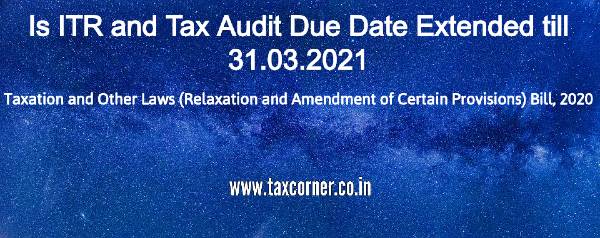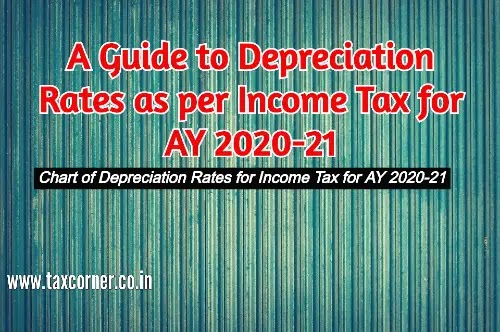Every year after the presentation of the Union Budget by the Finance Minister, everyone is interested to know about the income tax slab and tax rates for the forthcoming year so that one can calculate how much extra tax one has to pay or how much he has saved.
The Union Budget announces the tax slab and tax rates ahead of the commencement of the next financial year. The Union Budget 2021 is presented on February 1, 2021. Various tax proposals were announced in the Budget 2020 and proposals are contained in the Finance Bill, 2021 to amend the Income Tax Act, 1961.
There are various tax rates provided in the income tax law which is based on the status of the taxpayer. The income tax slab and tax rates are defined for every 'person' under the Income Tax Act, 1961 (hereinafter referred to as "the Act"). The tax liability is calculated on the basis of the applicable tax rates for the relevant assessment year.
Under the income-tax law, tax rates are of two types-
(i) Tax rates on the basis of income-slab
(ii) A flat rate of tax on the income
Income tax slab basis - is progressive taxation and tax rates on this basis are defined for Individuals, HUF, Cooperative society, AoP, BoI, local authority, and AJP. In the income-slab basis, the tax rate increases as there is an increase in the level of income. Thus who earns more pays high tax as compared to those earning less. It gains importance due to the fact that in this case, a level of income is set on which no tax is charged which is called 'basic exemption limit'.
A flat rate of tax- is levied on the income irrespective of the level of income. Every income earner pays the tax at the same rate and no discrimination is done in any case. Companies and firms are taxed on a flat rate basis.
In common parlance, the rates of tax applicable to Individual assessees or taxpayers are called 'Personal Income Tax' and the tax rate applicable to companies is called 'Corporate tax'.
The personal and corporate tax rates are contained in the Finance Acts and not in the Income Tax Act. Every year the Finance Minister along with the Union Budget presents the Finance Bill, which after the receipt of assent of the President of India, becomes a Finance Act.
A Finance Bill (or Act) contains two sets of tax rates- one is for the current year in which the Budget is presented and the other one is for the forthcoming year.
As we know, every year the Union Budget is presented in the month of February. This year the Union Budget, 2021 was presented on 1st February 2021.
Thus, the Union Budget, 2021 was presented on 1st February 2021 and the Finance Bill, 2021 was introduced.
The Finance Bill, 2021 will contain the tax rates for FY 2020-21 (current year) as well as the tax rates for FY 2021-22 (forthcoming FY).
In the next Budget in February 2022, the tax rates provided for the forthcoming FY 2021-22 in the Finance Act, 2021 will become the tax rates for the current FY 2021-22 and will also contain the tax rates for forthcoming FY 2022-23. This is how the tax rates are prescribed in the law.
As stated above, the Finance Bill, 2021 provides two sets of tax rates-
One for the current FY 2020-21 (February 2021 falls in the FY 2020-21), and another one is for the forthcoming FY 2021-22.
It is pertinent to note that the Finance Bill, 2021 has not changed the income tax rates as applicable to all the assessees for the AY 2022-23 (FY 2021-22). The same rate of income tax and income slab, as prescribed by the Finance (No. 2) Act, 2019 and the Taxation Laws (Amendment) Act, 2019, shall be continued in AY 2022-23.
This is except for the new optional simplified income tax rate introduced for individuals and HUFs and a resident co-operative society.
Finance Bill, 2020 had introduced two new sections - Section 115BAC and section 115BAD in the Income Tax Act, 1961 to provide for the optional simplified income tax rates for individual and HUF taxpayers and a resident co-operative society. The new optional simplified income tax rate was made applicable from the assessment year 2021-22 (FY 2020-21).
Applicable Income Tax Slab Rates for AY 2022-23 (FY 2021-22) for Individuals/HUF/AoP/BoI/AJP:
Table-1
Table-2
Table-3
Remarks: A Non-Resident Senior Citizen or a Very Senior Citizen Individual is not entitled to additional relief on income-tax slab rates. Only a Resident Senior Citizen or a Very Senior Citizen Individual is entitled to additional relief on income-tax slab rates.
New optional simplified income tax rates for Individual and HUF only under section 115BAC
Table-A
A comparative tax rate chart under both the old regime and the optional new regime is given for ready reference-
The following rate of Surcharge, Marginal Relief, Health & Education Cess and the Rebate u/s 87A shall be applicable to the old regime and the optional new regime.
An exceptional provision is provided where the total income includes any income chargeable under section 111A and section 112A of the Income-tax Act, the rate of surcharge on the amount of income-tax computed on that part of the income shall not exceed 15 percent.
[Rate of above-mentioned Surcharge as amended by the Taxation Laws (Amendment) Act, 2019]
Table-4
New optional simplified income tax rates for a resident co-operative society only under section 115BAD
Table-B
Table-5
Table-6
Table-7
Table-8
Optional Corporate income-tax rates for Assessment Year 2021-22 [introduced by the Taxation Laws (Amendment) Act, 2019]
Table-C
Table-D
Conclusion
It may be noted that the New Corporate Income Tax Rates mentioned in Table-C and Table-D are optional to a domestic company. If such a company does not opt for reduced New Corporate Income Tax Rates then it may continue to pay as per tax rates specified in Table-7.
Further, it may be noted that Surcharge on income-tax in Table-C and Table-D is applicable without any threshold limit of total income.






0 Comments